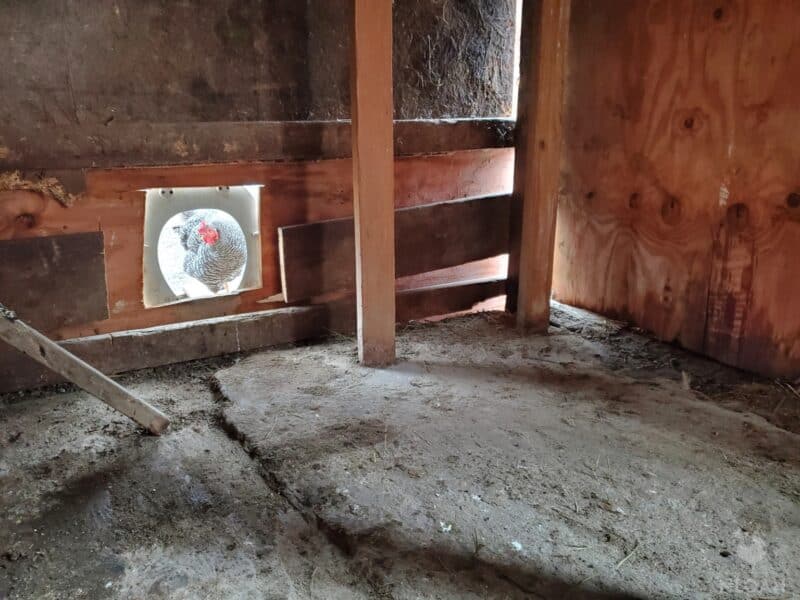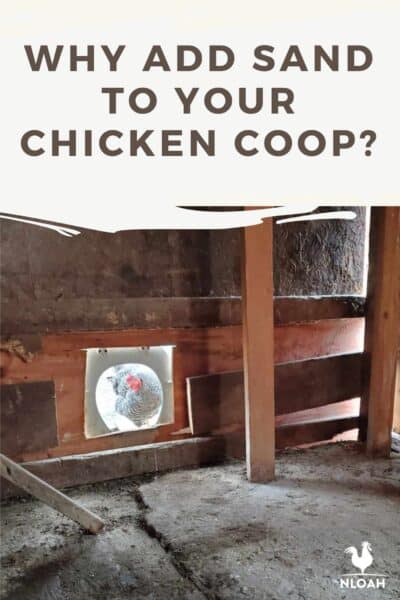Every chicken owner knows, and if they don’t know they find out quickly enough, that their birds need bedding in the coop. It’s good for sanitation, it provides a little bit of insulation and also something soft for chickens to walk on, protecting their feet.

But invariably, chickens will ruin their bedding in time, and that means you need to change it out: a gross, time-consuming and often expensive chore.
But, some homesteaders are making the change to sand and raving about the results. Interesting stuff, but why should you add sand to your chicken coop?
Well, sand has many advantages over traditional chicken bedding. It cuts down on bad odors, can be cleaned and reused easily, won’t rot and supports far less bacteria than other types.
I don’t know about you, but that sounds like a surefire winner to me when it comes to material!
However, for all of its many advantages sand does have drawbacks. If you are thinking about buying sand and just throwing it down over the existing bedding in your coop, you might be setting the stage for major disappointment and hassle.
Luckily I’ll be answering the most common questions about using sand in the chicken coop below, and telling you what you need to know to implement it. Grab your transfer shovel and let’s get going.
Why Would You Use Sand Instead of Other Bedding?
Let’s break down those benefits that sand has. Why would anyone pick it over other, tried and true bedding materials?
It cuts down on odor. Sand has a tendency to dry out quickly, and that means it will pull moisture out of chicken poop and dry it out, cutting down on the nasty smells that naturally come from it. Even better, when it is laid properly, poop will get buried in the sand and basically locked away, preventing chickens from walking on it.
Sand is easy to clean and reuse. You probably already know that most types of bedding can’t be reused at all; they get ruined, they have to be thrown out and subsequently changed.
But sand can be raked to remove solid waste and other debris easily and quickly, and the sand itself can be washed with water or rain and then dried in the sun, ready to be replaced.
This is a huge advantage when it comes to the life of the bedding and cash savings in the long run!
Sand won’t rot unlike straw, wood shavings, and other organic materials. It’s really just tiny rocks and other materials that won’t break down except through mechanical action or erosion.
Practically speaking, assuming it doesn’t get lost or ground into the soil, it will last forever.
Sand inhibits bacterial growth. Lastly, because it won’t rot, because it dries quickly and doesn’t retain moisture, and because it tends to desiccate chickens’ droppings it supports far less bacterial growth, both in kind and in total population compared to other types of bedding.
Assuming you’re keeping hygiene protocols where they need to be otherwise this is only a net improvement for the health of your flock.
Those are some wonderful benefits all right, and certainly reason enough to consider using sand as bedding…
What are Some Disadvantages of Using Sand in the Coop?
Nothing is perfect, and everything has a trade-off, and the same applies to sand as bedding material.
For all of its beneficial properties, sand has drawbacks namely in the fact that it is a poor insulator, meaning it won’t do much to keep chickens warm when it is cold and it won’t do much to keep them cool when it is hot. Proper coop design and maintenance can offset both of these disadvantages, however.
And, in less than ideal conditions, sand can be uniquely hazardous: it gets very hot when exposed to direct sunlight or to any other heat source and that can burn the feet of your poor chickens. Likewise, if the sand is allowed to stay wet and then a cold snap comes through it can freeze, presenting both a physical injury hazard and clumping onto the feet and feathers of chickens. Neither outcome is good!
Another thing to consider is that your chickens won’t be scraping and scratching through the sand looking for tasty morsels in the form of bugs and other critters, either; most creatures simply will not live in sand the way they will in dirt and other organic detritus.
These are definitely disadvantages, but they are easier to work around than you might think. Just keep them in mind and do your own cost-benefit analysis before you switch to sand. In the meantime, I’ll tell you more about it in the following sections.
What Sort of Sand Should You Use?
Without question, the single biggest argument that pops up among chicken owners online is what type of sand is best for chickens.
I’ve heard literally every kind under the sun recommended, but in my observation this problem is magnified because of the variable naming conventions under which typical types of sand are sold…
In other words, one vendor might call it one thing, and another vendor could give the same sand an entirely different name. This sort of leads to a “who’s on first” if you remember that old Laurel and Hardy skit.
Anyway, let’s cut to the chase: if you use common construction sand or river sand your chickens will be just fine. You don’t want to use common playground sand.
To be more specific, construction and river sand both have somewhat larger granules than is typical of playground sand and the size of the granules is variable.
This does two important things for us: first, it drastically cuts down on dust, as airborne dust is a significant hazard to chickens. Additionally, it improves drainage which is an important consideration if you’re going to make the switch to sand.
In short, as long as you are getting any clean sand that has been sifted for major debris, that has a larger and somewhat variable particle size and is a low-dust variety with no additives or other strange stuff your chickens are going to love it.
Can You Lay Sand Over Existing Bedding?
No! Or rather, I should say no unless you are laying it over clean dirt. You should never lay sand over other types of bedding, including straw, pine needles, wood shavings or anything else.
You should only put sand down over clean dirt, plywood, or most preferably a layer of small gravel to serve as a substrate. The latter will significantly improve comfort, cleanliness and drainage.
How Deep Does Sand Need to be for Chickens?
Ideally, you’ll lay at least 3 inches of sand for your chickens whether you’re laying it on plywood, dirt or gravel. But 6 inches of sand is best. This will mean it is plenty deep for your chickens to dig and pick through without hurting their beaks or feet and it will provide plenty of space for that poop to sink and dry out.
Note that if you are laying your sand over a gravel layer, which I highly recommend, your gravel layer should only be about 3/4 of an inch deep, an inch at most. Plan and purchase accordingly!
You Still Need to Provide for Drainage!
One thing to keep in mind with sand is that even though it is quick drying and drains easily it will only do that if the substrate it is on likewise drains well and dries out. This means that putting sand directly over dirt is problematic if it routinely becomes muddy for any reason. This could be a leaky coop, groundwater issues or any number of other problems. Remember that if sand stays wet and then cold weather comes the sand can freeze and cause injury.
To prevent this outcome, either lay the sand on top of a solid coop floor like plywood, or lay down drainage tiles first, then the gravel and then sand on top of that to promote better water control and give the sand some standoff from the soil.
Is Sand Okay for Chicks?
Yes, but only once they’ve grown up a bit. You never want to use sand in the brooder box because chicks shouldn’t eat it. Sand can cause significant crop injury at this stage of life and other problems. Once your chicks are ready to join the rest of the flock they can be on sand the same as the others, around 8 to 12 weeks old depending.
How Should You Take Care of Sand in the Coop?
Taking care of sand in the coop is slightly involved but much of the time easier than dealing with other bedding. Even better, the sand is reusable and stays cleaner a lot longer!
The first thing you need to do is get the poop out of the sand but you can do by scooping it out if it’s visible or by raking the sand and then shoveling out the collected droppings.
If the sand is looking really bad it needs to be changed, you can remove it and spread it out on a tarp or other surface to be washed with a hose or by rainfall and then allow it to dry out with the sun. Extra sand is helpful here because you can simply put fresh in while you wait for the sand you removed to “launder.”
And remember, sand gets very hot when exposed to direct sunlight, so you want to shade it and let it cool a bit before you put it back in the coop when you’re doing a change.

Tom has lived and worked on farms and homesteads from the Carolinas to Kentucky and beyond. He is passionate about helping people prepare for tough times by embracing lifestyles of self-sufficiency.

Q- Couldn’t you rake the sand while chicks were behind a closed door?
Rake and blow out with a leaf blower? Are we thinking cat litter box?
Asking for a friend!